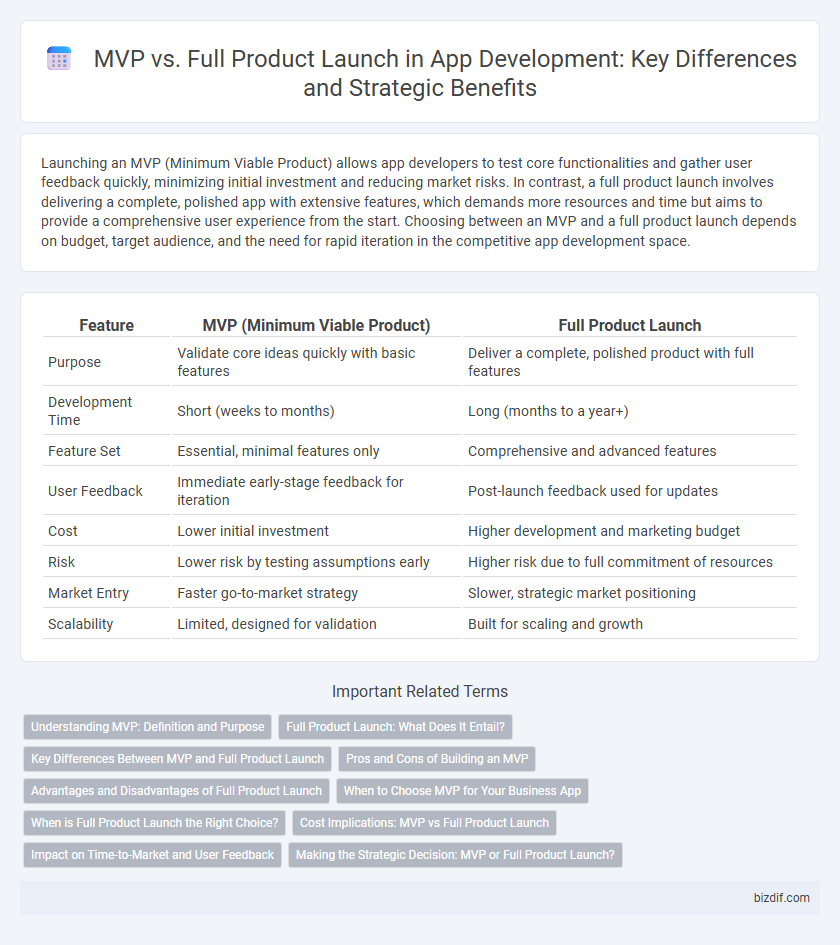Launching an MVP (Minimum Viable Product) allows app developers to test core functionalities and gather user feedback quickly, minimizing initial investment and reducing market risks. In contrast, a full product launch involves delivering a complete, polished app with extensive features, which demands more resources and time but aims to provide a comprehensive user experience from the start. Choosing between an MVP and a full product launch depends on budget, target audience, and the need for rapid iteration in the competitive app development space.
Table of Comparison
| Feature | MVP (Minimum Viable Product) | Full Product Launch |
|---|---|---|
| Purpose | Validate core ideas quickly with basic features | Deliver a complete, polished product with full features |
| Development Time | Short (weeks to months) | Long (months to a year+) |
| Feature Set | Essential, minimal features only | Comprehensive and advanced features |
| User Feedback | Immediate early-stage feedback for iteration | Post-launch feedback used for updates |
| Cost | Lower initial investment | Higher development and marketing budget |
| Risk | Lower risk by testing assumptions early | Higher risk due to full commitment of resources |
| Market Entry | Faster go-to-market strategy | Slower, strategic market positioning |
| Scalability | Limited, designed for validation | Built for scaling and growth |
Understanding MVP: Definition and Purpose
An MVP (Minimum Viable Product) is a basic version of an app built with essential features to validate core assumptions and gather user feedback quickly. Its purpose is to minimize development time and resources while testing market demand before investing in a full product launch. Focusing on the MVP helps identify user needs, reduce risks, and prioritize iterative improvements for the final app.
Full Product Launch: What Does It Entail?
A full product launch entails releasing a fully developed application with complete features, polished user interface, and robust backend systems to ensure scalability and reliability. It requires comprehensive testing, marketing strategies, and customer support infrastructure to maximize user adoption and retention. This phase focuses on delivering a seamless user experience and meeting market demands with a stable, high-quality app.
Key Differences Between MVP and Full Product Launch
An MVP (Minimum Viable Product) focuses on delivering core features to validate market demand quickly and gather user feedback with minimal resources, whereas a full product launch offers a comprehensive set of functionalities designed for a wider audience and long-term adoption. MVP development emphasizes speed, cost-efficiency, and iterative improvement, while full product rollout requires extensive testing, scalability considerations, and polished user experience. Key differences include scope, time-to-market, user feedback integration, and resource allocation, impacting product strategy and risk management in app development.
Pros and Cons of Building an MVP
Building a Minimum Viable Product (MVP) enables faster market entry and early user feedback, reducing development costs and minimizing risk by validating assumptions before committing extensive resources. However, MVPs may lack comprehensive features and polish, potentially leading to limited user satisfaction and negative brand perception if not managed properly. Balancing speed and quality is crucial to ensure the MVP effectively tests core functionality while laying a strong foundation for future full product development.
Advantages and Disadvantages of Full Product Launch
Full product launch offers comprehensive features that enhance user experience and provide complete market solutions, but it requires significant upfront investment in development, testing, and marketing. The extensive scope can lead to longer time-to-market, increasing the risk of missing early customer feedback and market validation. However, delivering a polished, fully functional app can establish strong brand presence and competitive advantage in saturated markets.
When to Choose MVP for Your Business App
Choosing an MVP (Minimum Viable Product) for your business app is ideal when you need to validate core features quickly while minimizing development costs. This approach allows gathering user feedback early, making iterative improvements before investing in a full product launch. Prioritizing MVP is crucial for startups aiming to test market fit and reduce time-to-market in competitive app development environments.
When is Full Product Launch the Right Choice?
A full product launch is the right choice when market demand is well validated, user feedback from MVP testing is overwhelmingly positive, and development resources are sufficient for a polished and feature-complete release. This approach maximizes brand impact and customer satisfaction by delivering a comprehensive solution that addresses key pain points without phased rollouts. Companies targeting competitive markets with high stakes in first impressions benefit significantly from a full product launch strategy.
Cost Implications: MVP vs Full Product Launch
Developing an MVP (Minimum Viable Product) significantly reduces initial costs by focusing on core features essential to validate the market fit, enabling faster feedback and iterative improvements. A full product launch demands higher investment in comprehensive features, robust infrastructure, and extensive testing, increasing budget requirements substantially. Strategic allocation of resources towards an MVP can minimize financial risks before committing to the larger expenses of a full-scale product deployment.
Impact on Time-to-Market and User Feedback
Launching an MVP accelerates time-to-market by delivering essential features quickly, enabling early user feedback that guides iterative improvements. Full product launches require extensive development, delaying release but offering a comprehensive user experience from the start. Prioritizing an MVP fosters agile adjustments based on real user data, while full launches risk misaligned features without early validation.
Making the Strategic Decision: MVP or Full Product Launch?
Choosing between an MVP and a full product launch hinges on balancing risk, resource allocation, and market feedback. MVPs enable rapid validation of core features with minimal investment, accelerating iterations based on user responses, while full launches require comprehensive development and stronger upfront capital but aim to deliver complete value from day one. Strategic decision-making involves assessing target audience readiness, competitor landscape, and internal capabilities to optimize time-to-market and product-market fit.
MVP vs Full product launch Infographic

 bizdif.com
bizdif.com